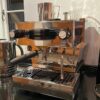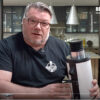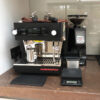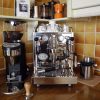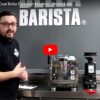This review is for the flagship dual boiler, pressure profiling model of Crems new range of prosumer machines. Bella Barista is the authorized dealer in the UK with Crem trained engineers, backup and support. It’s a very long review (sorry) because the machines functions are interesting/innovative and need to be understood properly. To make it more readable I broke it down into sections. Even with a detailed review, full explanations of symbols, the menu system and many features are simply not possible. You can read Crems extensive user guide to get the detail on these things. I limited this to key features and interesting aspects of this machine, hopefully all part of your “purchasing decision”. Lastly, it’s a very candid review because I want you to be sure you understand what you are getting. It’s also important to check back with this review before you purchase, as Crem are working on some issues raised, and they may well be dealt with very quickly. I will update the review as soon as I have any news of new developments/firmware changes.
- Introduction
- Overview of features
- Four Different Shot types
- Recipes (Saving, Import, Export and Editing)
- Internal Tour
- The USB Port and upgradeable firmware
- Things I loved & things Crem added before launch
- Conclusion
Introduction
Why not download the actual brochure for the Crem range and acquaint yourself with the marketing and nice photos. Click the link below to download it directly from the Crem site.
This review will be about actually having it on a kitchen counter and the functional/technical aspects of the machine on a real world user level after more than 3 months with it.
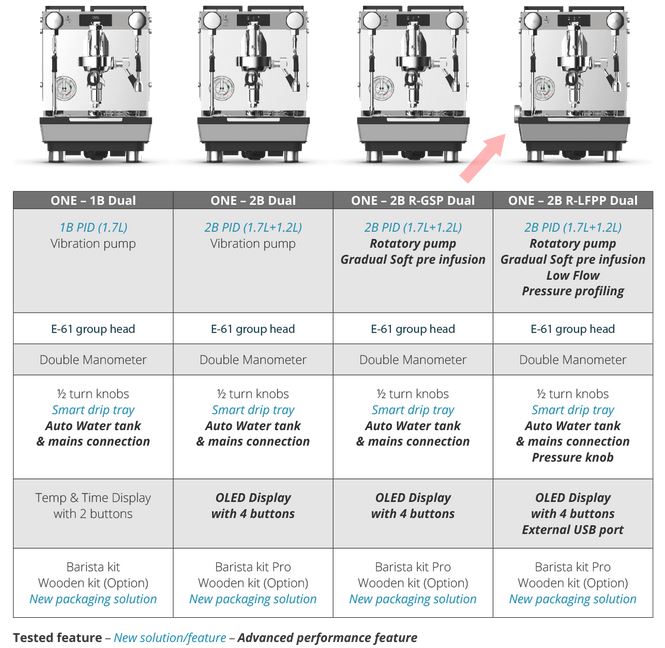
The Crem One 2B R-LFPP Dual is the first prosumer pressure profiling machine from Crem, part of the first real new batch of prosumer machines from them in over a decade. Coming later than others to the market means some out of the box thinking, less rooted in the traditional evolution of machines during the last 10 years.
It represents the flagship of the new line-up. Featuring a small (simple) OLED centrally placed above the group and 4 real buttons, no capacitive touch screen here. On the lower left-hand side of the case is the “Barista Knob”, used in conjunction with the screen to select many functions and control profiling. In a moment of idle speculation, I realised that if you are missing your left arm (for whatever reason), this may not be the machine for you.
It uses a Traditional E61 group (almost) and unusually the mechanical pre-infusion has been left enabled to support non profiling shot types better. Otherwise the layout of the machine is fairly standard except for: A very large drip tray for those lazy people amongst us. On the unit I have, it also serves to contain ALL the water from the large brew boiler (1.2l), as I have a drain tap that drains the brew boiler water to the drip tray. A angled mirror finish at the bottom of the front panel gives a clear reflection of the underside of the group for watching those naked portafilter holes, essential when profiling.
They seem to have taken their ECO credentials quite seriously with ECO packaging. It works, but doesn’t look great and feels like something you would not want to reship the machine in. All the accessories are inside a sort of corrugated cardboard that’s mostly air. The box actually opens like the old Dalla Corte boxes, lifting up an outer shell to reveal a coffee machine, you just have to open the top first to remove the accessories tray!
After that the sides (cut the tape at the bottom), then the machine can be accessed sitting in its little ECO tray (top left photo). You can see a piece torn away, that’s to get your hands under the base….the ONLY place it should be lifted from!

The construction of the machine shows innovation mixed with tradition. It uses a strong polycarbonate base, traditional copper boilers (1.2l brew and 1.7l service), copper piping (plus some PTFE Piping) and then a Mix of steel and polycarbonate throughout the machine. I liked the polycarbonate base for a number of reasons.
- Saves weight (although the machine is still really heavy)
- Very strong, but can flex rather than bend in rough handling
- Very accurate for placement of interior components
- Cannot Rust
- No sharp edges at all underneath
- Minimises vibration
Accessories
Your dealer may give you extra things but the standard accessories that come with the machine together with the plumbing kit include:
- 3 Filter baskets 7, 14 and 21g (I found the 14g basket fine for 17g of coffee)
- Cleaning Brush
- Cleaning tablets blister (didn’t get those, but I’m hope you will), if not buy a tub of Puly cafe.
- Blind metal filter
- Flat metallic tamper
- Extra Nozzle steam tip 3 Hole
- Milk jug 300ml small
- 1 x double narrow spout portafilter
- There is also an In tank water filter cartridge which I don’t believe was ready when I got the review unit but as I have boiler safe water, I wouldn’t have used it anyway.
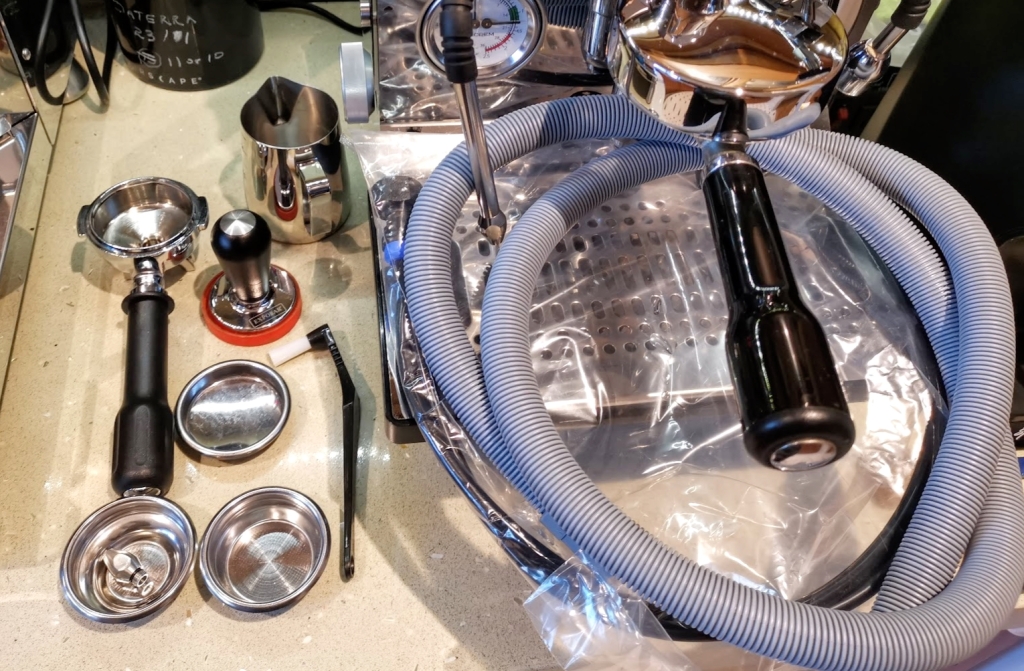
Overview of features
The Crem One 2B has so many features and functions it is difficult to list them all. I will limit my explanation to those unusual ones and simply list the more usual (expected) features. So lets get the standard stuff out of the way. You can read all about this in Crems Brochure, what follows is what’s not really covered well in the marketing and cool stuff that needs more explanation.
- E61 group (almost completely standard)
- No compression steam/water wands 1/2 turn on/off
- Ball joint steam and water wands (cool touch).
- Height adjustable feet
- Removable mains cord
- Dual analogue Brew Pressure and Steam pressure gauge
- Internal Tank (easily removable for cleaning)
- Drip tray drain facility
- Mains plumb-able (auto detects when mains plumbed). Accessories provided for this
- Cup warmer rack
- Dual Height drip tray (removable insert)
- OLED Display (Monochrome) with 4 push buttons
- Easy access to water tank (removable for cleaning). No tubes in tank
- Large Cup warming tray with clear demarcation of water tank hatch
- Dual boiler, no need for cooling flushes like on HX machines (less water used, less tank filling)
All very interesting, all great but now on to the cool stuff.
Unusually Low temperature offset
I’ve not ever covered temperature offsets in detail before. It is the difference in the displayed brew temperature setting and the real temperature detected in the water. The actual brew temperature of the water reaching the coffee puck is always lower than the brew boiler temperature (for technical reasons). Manufacturers (apart from one, who makes you look at a graph to work it out) program in an “offset” to show you the predicted temperature of water reaching the coffee rather than the real unadjusted temperature of the brew boiler.
Typically, brew boilers are about 10-15C hotter than the displayed temperature e.g. have an “offset of 10-15C input. This offset allows for cooling of the water as it passes to the group and within the group before it reaches the coffee.
10C is the lowest offset I have ever come across and low is good for technical reasons. Crem had used 10C but my tests showed this was too high and an offset of 7C is all that is required. This is the lowest offset I have ever seen on an E61 dual boiler and for technical reasons (outside the scope of this review), it’s a very good thing.
Miniature Rotary Pump and DC Brushed Motor
This little unit is compact, specially mounted to be almost vibration free and near silent unless used at its extremes of pressure/flow. It’s a new unit from Fluid-O-Tech and I think represents an interesting solution for rotary pumped machines in the future. Current prosumer rotary pumps are almost commercial size units and can be noisy.
It’s called the GA Series Pump Motor Unit and you can see it mounted in a specialized silicon rubber sleeve mount to keep it extra quiet and vibration free. It is actually a clip in and out fitment for easy maintenance once the tank carrier above is clipped out.


Barista Knob
A heavy aluminium knob with an infinite clicky turn action, plus a push action for selection. This knob on the lower left-hand side performs manual profiling as well as duplicating some menu selection functions. The main OLED display has 4 buttons but sometimes it’s easier to perform certain menu actions using the Barista knob. Best to find which menu things it can control for you via trial and error (as firmware will be updated over the years), can save much button pushing!

Rotating the knob during profiling increases pressure by either 0.2 – or 0.5 bar per click (configurable). It also quickly allows you to select the profile recipe you want. I have mine set to 0.2, but might change it to 0.5 for less spinning the knob when manually designing a profile.
Very Large “Smart” drip tray with water level sensor and brew boiler drain tap
The drip tray holds around 1.8l of water and has level sensing (see red arrow) to give you a visible warning when it’s full. It slides into place and actually has a weak magnetic link to hold it securely.
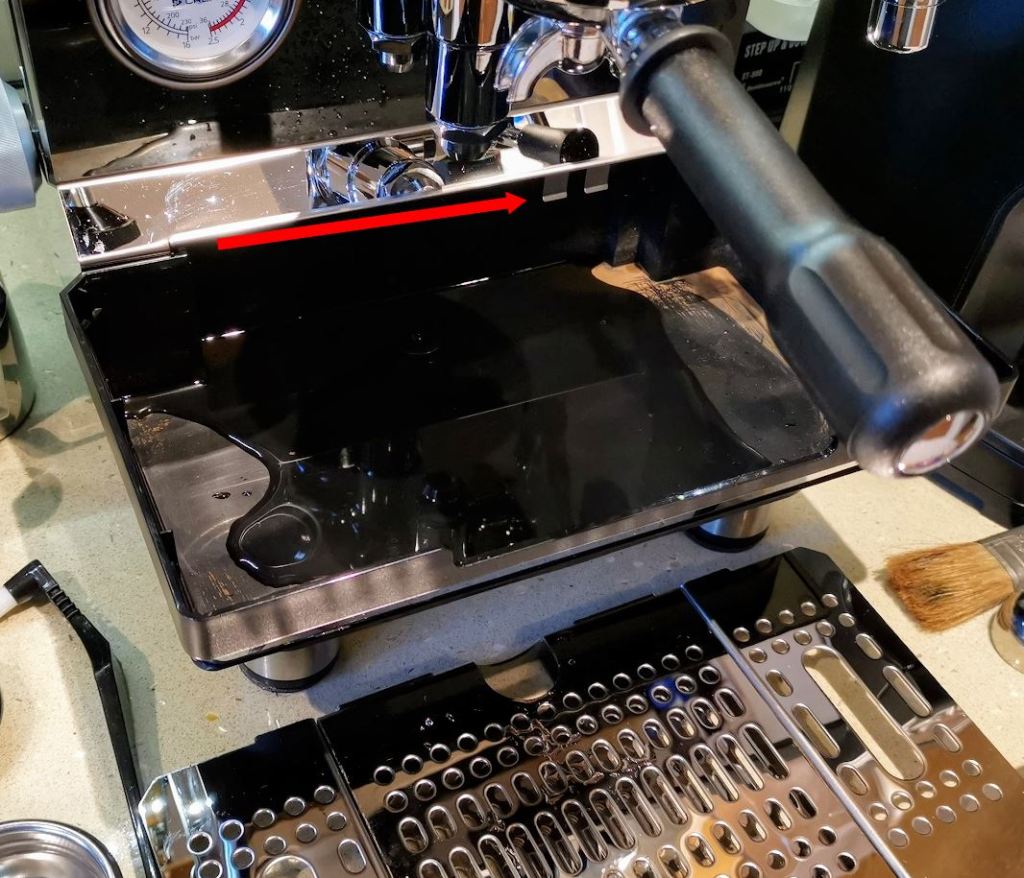
I wondered what the thinking was to make it so large until I discovered the brew boiler drain tap underneath the machine. Twisting this valve allows the brew boiler to be completely drained into the drip tray. Absolutely fantastic and probably the best brew boiler drain system I have ever seen. If you are overwintering the machine outside in a cold environment it’s essential to drain the boiler to prevent freezing and if you need to descale, it makes the whole job so much easier, a DIY task in fact. There are a few things to be aware of when using this function and I will touch on them later.
If you’re super lazy, you can go a very, very long time before emptying the drip tray and even create nice green floating things inside.
Angled reflective front
The angled front lower panel edge is highly reflective, it gives great view of portafilter basket bottom for fine-tuning those shots. Crem thought about this but for some reason, decided not to include a bottomless portafilter in the accessories kit. Make sure you ask your retailer to add one to your order!
USB Port
This specific model has a USB port at the back (there is another model with the USB port inside the case). This is interesting for 2 reasons.
- You can save, load and share recipes with others using a USB key.
- You can use it to upgrade the firmware of the machine for new, revised or improved functions as they become available from Crem.
I consider this quite an important feature as we will find later. One thing that makes thing awkward, is the location of the USB port at the lower rear of the machine. It’s not particularly easy to reach or plug a USB key into and the little rubber waterproof flap gets in the way. This was quickly and easily solved by purchasing a male to female 0.5m USB extension cord from Amazon for 99p.

Removable drip tray insert
The drip tray is quite a hefty thing and the steel very thick. It is unusual in that it has an insert in the centre that is removable to allow the placement of scales and the use of taller cups.
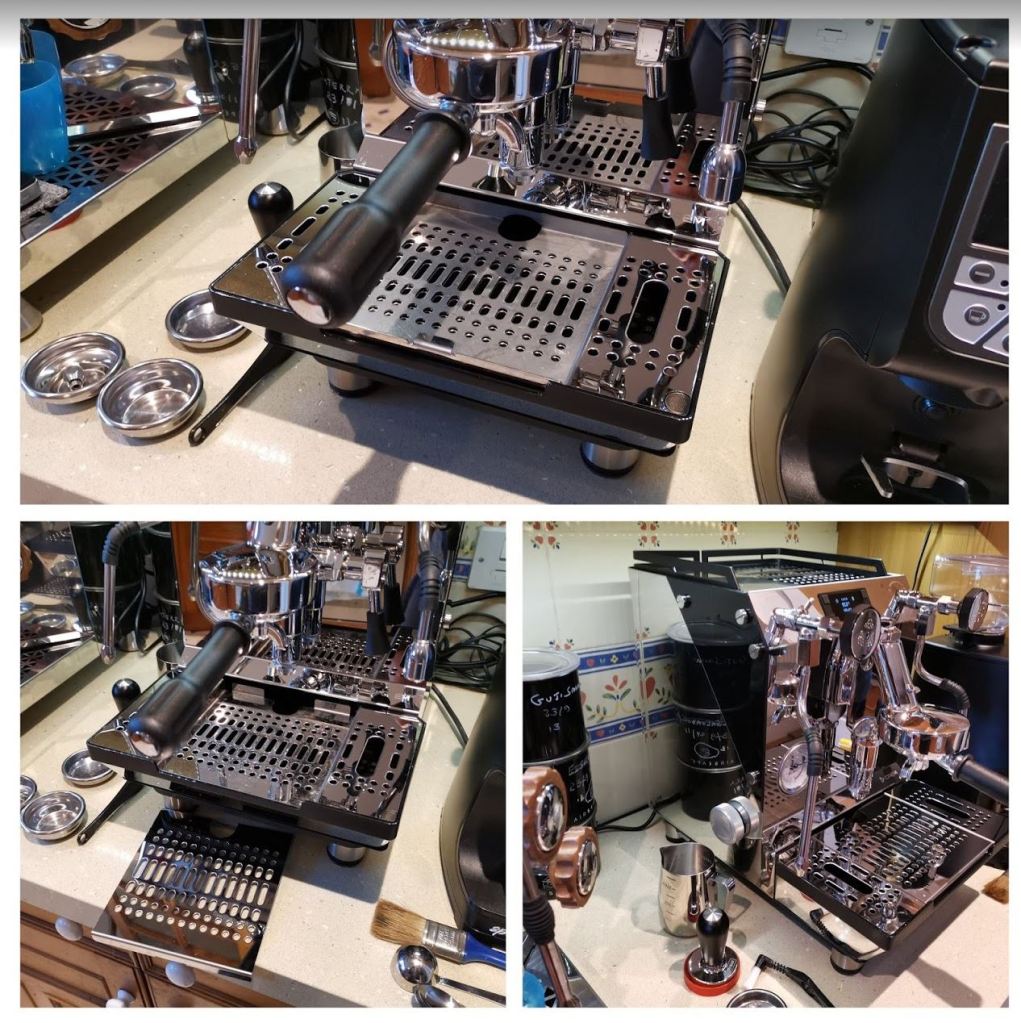
The middle tray when removed fits handily between the front feet under the machine so it can be out of the way when not in use. The photo above shows the drip tray in place normally, upside down, removed, and about to be slid under the front feet.
The larger photo shows what would have been my preferred option, to have the insert polished on both sides and reversible, as the holes all line up perfectly. This allows it to be replaced upside down, hides the rather gappy appearance at the rear when it’s removed and is stored in plain sight. I have fed this back to Crem, whether they will change it eventually or not, I don’t know? I hope so because I think it would be a more “elegant” solution.
E61 Group Dispersion system
I said the group was almost completely standard, but there is a small difference in the dispersion system design. It’s one I have never seen before and I feel it’s worthy of mention.

The standard dispersion disc has a slot with a hole in the centre (bottom right), the slot also serves as purchase for a screwdriver to unscrew the dispersion disk. The Crem has a hexagon in a dished shape with 6 radial channels cut in it. If you look at the shower screen with the centre blocked out (no holes) as is common on most/all shower screens. The Crem Idea is to obviously give a better dispersion of water and more even flow from the screen. It also gives a much larger volume of water above the screen (in total almost 50ml is contained in the area above and below the screen) as there is more empty space. I think this will be beneficial, even out shot temperatures and improve infusion of the coffee at low pressures. It was certainly borne out by nice stable temperature measurements 3mm within the coffee puck. I do like it when I see someone has thought about little details like this.
It still uses a standard shower screen and gasket, so no worries about specialist spares.
Capacitive water sensing
I like capacitive water sensing and have it on one of my other machines. It detects low water level in the tank without any floats or wires to electrodes or anything like that. On my other machine the sensitivity is set well and it is reliable. However, this is not always the case and they can be problematic if the sensitivity/placement isn’t correct.
The Crem machine gives “last shot protection”, the last shot always tries to complete rather than stop with a tank empty message. This is time based and with long and high volume profiles this can sometimes allow the tank to empty completely. On my test unit, the sensor may need adjustment to make it less sensitive for a higher water level at low water detection. This has been fed back to Crem to ensure production machines are adjusted correctly.
Built in On/Off timer
It can be set to switch on and off once per day using a daily timer with a separate on/off time for each day. It does this from standby and the main power switch is left on. The machine can manually be put into standby by long pressing the top left button on the display if the main power switch on the front (a metal pin switch) is turned off then the machine is fully off…not just in standby. Useful if for whatever reason you don’t want timed wake up.
In earlier firmware, the system resumes from a mains outage in the ON state regardless of the on/off timer setting, this is useful if you want to run it from a smart plug and have a more complex schedule and remote switch on/off, power monitoring etc..
Ideally, after an electricity outage, upon restoration of power, the machine should return to the power on/off state it was set to. Crem have implemented this in the current firmware upgrade.
Four different shot types
Gradual Soft Preinfusion (GSP)
This is the default mode the machine operates in if you have not set a recipe, are manual profiling or using QSP. I like this feature much more than I realised I would. There are a few great things about it: Firstly, it’s a completely separate system from the pressure/volumetric profiling subsystem. This means a fault in the pressure profiling system e.g. pressure sensor, leaves the GSP system completely unaffected. Secondly, it’s a very flexible walk up and shoot mode that the machine can be left in for users who can’t, or don’t want to profile the shot..
The system is simple to configure….you set a start voltage (anything from 5V upwards) and a time, anything up to 30 seconds. The system then ramps the voltage to the pump motor from the start voltage to the full 24V, over the time period chosen. e.g. start voltage 6V, time 20s. The pump motor will gradually speed up and apply pressure, reaching maximum power after about 20 seconds. It is a “set and forget” function.
The maximum pressure reached is 10 bar or a lower value if the expansion valve maximum is reduced. Reducing max pressure via the expansion valve affects the maximum pressure that can be delivered for any function of the machine. Screw it anticlockwise to reduce pressure, although I recommend the machine is left set at 10 bar for more overall flexibility in the range of shots it can produce.
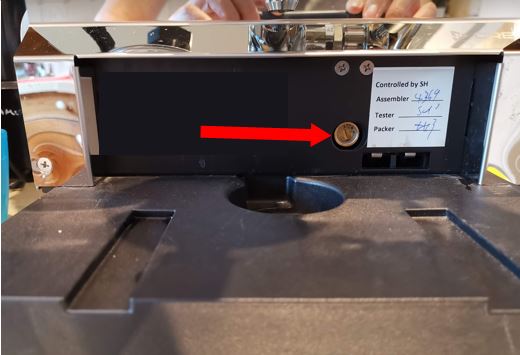
This next video shows GSP set to 5V (the minimum) and a 30s ramp time (the maximum)
I would love Crem to develop this system further in future firmware updates. There is an opportunity to improve the function and flexibility of GSP by adding an end voltage. It would make the pump even quieter and allow a “fine tuning” of the function to reduce flow rate and/or pressure without affecting other system functions by adjusting the expansion valve. This could increase the range of shots from this great function.
Quick set pressure (QSP)
This is slightly different to a profiling shot although it does use the same subsystem. I have invented a term I call QSP. It’s quite common for people using E61 machines to enjoy a shot at pressures other than 9 bar. Some people prefer 8 bar, others as low as 6 bar, apparently tasting reduced bitterness and other desirable characteristics. Certainly as pressure drops it’s likely fewer oils are extracted and thus less bitter compounds. The lower the pressure for the shot, the more the movement from espresso to a form of rapid brew coffee. The Crem machine will allow you to experiment with some very low pressures (as long as you don’t drop below service boiler steam pressure) for extended durations to get this type of fast brew coffee, or 6 bar+ shots to get the type of smooth espresso some enjoy. An example of this technique is in the video below. The trick here is to experiment with grind, volume and pressure to find interesting alternatives (handy that the E61 preinfusion chamber has been left enabled).
Adaptive Pressure Profiling
I just had to invent a name for it. Pressure Profiling on this machine is interesting and quite different to the usual approach taken. Usually there is a pressure by time approach. 10s at 2 bar; 5s at 4 bar; 10s at 9 bar and 10s at 7 bar, for a total shot time of 35 seconds. The volume/weight of espresso extracted is greatly affected by grind fineness and coffee type.
This is a way of standardising on a profile for a particular coffee and is time based for the duration of each pressure stage. If the coffee is far too finely ground, it will still take 35s to complete all the stages but might give hardly any coffee out. If the coffee is too coarse, it still takes 35 seconds and gives lots of coffee out (a gusher). If the coffee is just right the profile works as intended. However, when you change coffee, you will have to change grind and the profile will work somewhat differently even though it might give the same total shot time
The Crem One 2B profiles by volume which is a very interesting approach and it seems to give a higher success rate of good shots. In the hypothetical profile shown below 70ml of brew water is passed at 2 bar before the pressure rises to 5 bar and then 20ml of water has to be passed before it rises again to 9 bar. Finally, the last 6 ml is passed at 7 bar.

Initially during the shot the first 65 to 75 ml typically fills the head space in the portafilter and wets the coffee in the puck. The remaining 35 or so ml actually pushes through the coffee and ends up in the cup. Now we don’t know, or care too much about how fast the profile went as long as it’s not too long or short e.g. something in-between 25 and 45 or so seconds is usual.
So what happens if we not make the grind finer? On a normal pressure profiling machine the shot time would be the same, but less coffee would end up in the cup and the puck might fracture because insufficient water passed through before the pressure rose and compressed the coffee bed. On the Crem something different happens.

It’s taken longer but the volume of brew water passed is the same for each pressure stage, the total shot volume is the same, the shot (and each stage) just takes longer. This is very important because it’s saying; I know you wanted to pass a certain amount of water through the coffee for each pressure stage, so I will take the required time to do that. This means that in the low pressure 2 bar stage, if it took 70ml to properly wet the coffee bed, it will give enough time to pass 70ml before moving to the next pressure stage. A normal profiling machine will just give you n seconds and move on, whether the bed is properly wetted or not.
Now there is one caveat here. The programmers were smart enough to program a fake 1ml per 3-4 seconds flow rate even if there is no flow. So if you grind a lot finer than required for the profile the machine will eventually move through all pressure stages and the volume extracted will be a bit less, or a lot less if very fine (even stalling profile progression to a time-out).
It’s quite smart programming because it means the machine will never get “stuck” always completing it’s profile in around 90s no matter how fine you grind. e.g. the first 60 or so ml fills the head space quite rapidly (few seconds), the remaining 30 or 40 ml even if it completely chokes will be counted out around 90 seconds later, the shot will stop and you will see the lower lever signal.
I guess the best term I can think for the Crem One 2Bs profiling system is “Adaptive Profiling” Within limits it adapts to the grind level used. I could for example make a profile with varying pressure stages that takes 30s to complete extracting out a certain volume/weight of coffee in that time. If you use that same profile with a finer grind you might get almost the same volume/weight of coffee out in 45s. Or if your grind is coarser than mine, you may get the same result in 25 seconds. I made a couple of videos to try and illustrate this better.
Each of the above examples will taste subtly different of course, but the profile will always attempt to extract the same volume through the coffee for each discrete pressure stage
Here is a video showing adaptive profiling actually working with a change in grind fineness. Viewing on a TV screen is recommended as the displays are a little clearer.
Re-read this if necessary because it’s an important concept to understand when designing profiles and using the Crem One 2B. It’s an interesting approach to pressure profiling and one that gives different results to the normal approach. I have enjoyed experimenting with it but I wish the Crem programmers had detailed how it all works…never mind, I worked it all out (mostly) in the end.
Note: For technical reasons, pressures lower than service boiler pressure are not recommended when using the profiling system and could give unusual results. I recommend minimum pressures of 1.2 bar if the service boiler is on. If Crem introduce the ability to switch the service boiler off then pressures down to 0.4 bar can be used when the service boiler is off. Although I should stress that I don’t believe very low infusion pressures below about 1.2 to 1.5 bar are. Certainly the way a volumetrically controlled system works can make for some unusual results when using very low infusion pressures.
Now I’m probably going for a snoozefest here but it’s important you understand a limitation (despite all the advantages) of this type of adaptive pressure profiling vs timed pressure profiling. There is a type of shot you cannot do, this is the soak the puck at very low pressure and then wait a number of seconds before raising the pressure. This is because should the flow completely stop at a volume/pressure where the next pressure rise cannot be triggered within the 90s pump timeout, the shot will simply stop because it cannot progress due to insufficient volume! A timed profile will continue with pressure changes regardless of flow. You are likely to run into this when creating a shot at very low pressures for a long time to presoak the puck and then tightening the grind further using that same profile to prevent too fast a flow when the pressure increases. For this reason I don’t recommend you use pressures less than 1.5 bar until you have lots of experience with the machine and if the service boiler is on, never use a pressure lower than the service boiler pressure because of the preheat HX.
More detail is outside the scope of this review but I will be doing some extra videos for Bella Barista Customers.
I actually see this as a future opportunity for Crem to add “timed pressure profiling” to the R-LFPP machine as an extra shot type.
This video shows creation, saving and renaming of a profile and I used the opportunity to create just the sort of “on the edge profile” I talked about above. If I actually tightened the grind further and attempted to run that profile. I would probably run into the issue of insufficient flow for the shot to progress. I have considerable experience with the machine, so I know what I can get “just” away with.
Manual Mode
Press the Barista knob in and you will see the lever symbol. This is using the Barista knob to dynamically control the pressure in the shot during real time but not saving the result as a recipe. It’s for people who like “flying by the seat of their pants”. The profile WON’T repeat if the lever is lifted again and the pump will not run.
This is important as lifting the lever without the pump running can cause a small void in the brew boiler and negatively impact the volumetric calculations for the next adaptive profiling shot you do.
After using manual mode, It’s either back to the main menu, or save in a recipe slot. Leave this mode by going back to the main menu or another menu and your masterpiece is lost for ever. So always keep a backup of your existing profiles, then any unexpected masterpiece can be saved for later review without losing an existing profile!
Recipes (Saving, Import, Export and Editing)
Recipes (Crems name for profiles) are stored in a plain text file that can be viewed and even edited with any text editor. I use windows notepad. A detailed discussion of recipe files, hand editing, computer and software logic is beyond the scope of this review.
A typical recipe is shown below. Starting at 1.4 bar and then gradually increasing to 9 bar, before dropping away to 7.2 bar eventually. The time will vary depending on how fine the coffee is ground. A standard built in count down of approx 1ml every 4 seconds regardless of flow reduces the chance of the profile stalling to a time out at 90s. The lower flow rates of finer grinds may give slightly less volume (weight) in the cup as you grind finer because of this built in countdown.
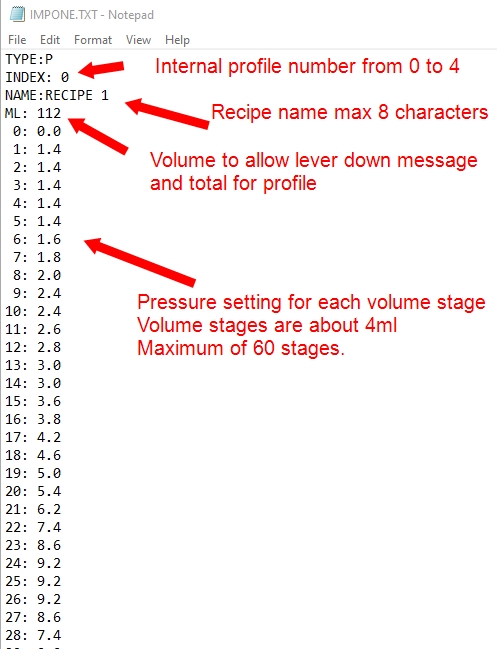
The system works well as a simple file for storage of recipes and something that’s editable (if you know what you are doing). When you save your recipes a file called EXPONE.TXT is created and when you import recipes the Crem One 2B looks for a file called IMPONE.TXT
Realistically, most users might limit editing to simply changing the “recipe name” of each of the 5 profiles, as naming them on the Crem machine is harder than simply renaming them in notepad. Or perhaps fine tuning pressure values a little. See the previous video.
There are other advanced little tricks you can do with editing, mainly around adding pressures/volume stages and the volume calculation for the lever warning and pump run on after 0 ml but this is all beyond the scope of this review. I look forward to Crem producing their application for the PC, making all this much easier.
When sharing profiles with friends you have to rename your EXPONE.TXT file to IMPONE.TXT before they can import it. Also when they import it, it overrides all their recipes, so make sure they save them! Currently, I store My recipe files like this.

Each folder holds and IMPONE.TXT file with those particular recipes on them. The root of the USB Key which is where the machine does it’s imports and exports to, simply has the current exported set of recipes. Or those recipes I intend to import copied from one of the storage directories.
In my opinion this recipe import, export, sharing system is a work in progress from Crem. I believe there is significant improvement still to be made and Crem informed me that they are working on a software application so users can create/edit profiles using the computer. I hope that they also include some sort of profile storage/management as well. I understand why they have files called IMPONE.TXT and EXPONE.TXT, rather than just RECIPE.TXT. As many people will want to export their recipes to save them before overwriting them with an import….although this could have been handled differently. There is actually quite a few things Crem could do with the naming, overwrite prevention and library management as well as creation of recipes, far more than can be speculated on here. I hope they will ask me to input to and test some of this work in progress before implementation.
Until then, I will limit myself to making some hand crafted starter profiles for Bella Barista to upload into their machines if they want to.
Internal Tour
It’s a fairly complex machine, many parts are standard and easy to work on for simple maintenance, other components. The pressure profiling subsystem and main board diagnosis should be left to retailers with technicians trained to work on this system.
It’s important not to attempt any end user modifications to this machine unless approved by Crem or authorized retailers. The system is complex and there may be unexpected behaviours and unintended consequences of modification.
I was surprised to find no safety valve on the service boiler. Crem said they have multiple safety systems of a limit stat on the boiler and fusible links in the heating element. I have been informed it’s compliant with both EU/CE regulation and UK PSSR regulations. Despite this, it doesn’t meet MY personal standards even if it meets regulations. For technical and safety reasons I like to see a safety valve limiting the maximum pressure in a service boiler. Especially when they fail progressively, visibly and noisily during a fault condition. I strongly advised Crem to consider fitting one as an extra safety feature.
This has been fully taken on board by Bella Barista and Crem who fitted and will continue to fit safety valves on all UK machines supplied to Bella Barista (this may not be the case for machines purchased from other retailers)!
The USB Port and upgradeable firmware
I have talked about this port in the review. It is at the bottom rear left of the machine as you look from the front and behind a little rubber flap. It’s actually annoyingly difficult to get a USB key in there by feel and most of us won’t want to 360 it on the bench to insert/remove a USB Key.


You can see the USB port protective flap on the right. This is what I plugged my 99p male to female 0.5m USB extension lead into. It’s the normal large size USB. I recommend a, cheap as chips 2 or 4gb USB key for a few pounds in FAT32 format. You will only use a minute fraction of the space on the key.
I think the huge value of this system is having the ability to upgrade the firmware at home without any special equipment. This allows Crem to share software enhancements directly with customers. You will be able to download new firmware as it becomes available.
many conventional machines have upgrades to firmware as they move through their life cycle, but usually the machine has to be returned to the retailer, or manufacturer for upgrading as most retailers to not have the facility to flash the various boards available. The flashing process is usually quite involved and requires mainboards to be removed from machines and individually powered with a display and laptop computer. There is also the risk and cost of shipping the machine back and forth, even if you still have the original packaging. With the Crem it’s simple as inserting the USB key and pressing a few buttons.
The machine is new to market and I believe there are lots of opportunities for Crem to enhance and add functions in the future. The USB port future proofs the purchase to some extent and removes any disadvantages for early adopters as they will have access to new firmware as it’s released.
Things I loved & things Crem added before launch
Loved
I loved the different shot types the machine can do beyond simply profiling, how quiet and vibration free it was in operation. The looks of the machine, size of drip tray, large dual analogue pressure gauge, all great features. A USB port means it’s future proofed for software upgrades and the facility exists to share and customise profiles in a way that’s not easy on other machines.
It produces some fantastic shots with good temperature stability together with the ability to simply tweak the grind to get some amazing results from the same “adaptive profile”. Shots you can’t get from timed stage profiling machines and would be extremely difficult (if not impossible) to get consistently from manually controlling pressure using a valve. The net effect of this, you may only have 5 recipes (profiles) within the machine but 3 or 4 separate grind settings for each giving up to 15 or 20 shot possibilities. Try this on a standard timed profile machine and it won’t work the same way at all.
It is a machine with significant potential as I feel Crem have only begun to explore the possibilities of the machine. e.g. The machine currently profiles on volumeterics what I call “adaptive pressure profiling”. In the future there would appear to be no reason (assuming programming space) why a function to profile using the more standard “timed stages” couldn’t be introduced as another shot type, further extending the significant capability of the machine.
The fact there are so many software opportunities that could be leveraged in the future to extend and enhance this machine,, the future is quite exciting. Lots of things about the machine I thought were great and one of the most important things…I really enjoy using it and it produces superb coffee.
We identified some functions/improvements we felt would be good to have at launch…
Crem listened and implemented them in the latest firmware!
The service (steam) boiler can be switched on and off independently – this allows you to operate with just the brew boiler on. For a modern machine with ECO credentials this is important. It helps extend the life of internal components. The machine will only consume about 70W with just the brew boiler on.
The initial heat up of the service boiler for steaming takes about 7-8 minutes. Good insulation means subsequent reheating takes much less time unless the boiler has cooled significantly. This has a much bigger positive impact than any “ECO” functions manufacturers commonly implement.
In addition, it allows for a future update for ECO mode to be extended, with a “time to off” for the steam boiler.
The brew boiler heating elements can now be switched off – This is not a function commonly found on dual boiler machines but it’s a good one to have. It seems relatively unimportant, but brew boilers in all dual boiler machines do not have water level detection. It’s why the first thing I suggest with any new machine to protect the brew boiler element is: Fill tank, plug in, lift lever, switch on, watch water level decline in tank. When water exits the group, lower lever, your brew boiler is full. The service boiler heating elements are usually disabled until the service boiler water reaches the right level, so it’s protected. If you purchase from Bella Barista, your machine will have been tested and should ship with the brew boiler already full.
This particular machine has the ability to actually drain the brew boiler via a tap, it’s also 1.2 litres. So it’s very useful (and important) to have the ability to disable the brew boiler heating element.
Simultaneous mode or Brew Boiler Priority can be set in the menu system. This now operates in 2 ways. If the machine is put in the special factory startup mode, it heats the service boiler first to protect the brew boiler which might be empty. It also instructs you when to lift the lever etc..
After first startup, the boiler priority is whatever is selected by the user, for the UK this will usually be simultaneous mode (both elements able to work at the same time). When switched on from cold, Crem implemented a nice little feature. In simultaneous mode, on cold startup they only heat the brew boiler first, once the brew boiler is within a few C of the set brew temperature, it heats the service boiler. This gives the fastest possible warm up sequence. Nice attention to detail.
They did some other cool stuff before launch.
Start up routine – the machine can be put in a factory start up state, if it’s being stored with boilers empty or shipped. This special mode prevents damage to the machine due to incorrect first time startup procedures with empty boilers
Extended the menu items selectable/scrollable with the Barista knob
The coolest of all, export and import of machine settings – it has to be on the same firmware version but if you accidentally “factory reset” your firmware, you can restore your machine set just the way you like it. For Retailers, they can easily make sure all their machines go out set the same way and can make that file available to their customers
Things I think could do with a closer look at in the short term
ECO mode could be improved in a future update. It reduces the temperature a little on the boilers to save energy. It only works on both boilers, when I really don’t want to step down the brew boiler temperature to save almost no energy. The group takes around 10 minutes or longer (aggravated because of the heating priority issue above) to fully stabilise in temperature after coming out of ECO mode. I would love to see a toggle between: Steam Boiler Only, Both Boilers, Brew boiler only. This way you have the option to choose, personally I would choose steam boiler only. The best, of course, is to run with the steam boiler off unless you need it on!
Crem should consider making Advanced PID Functions viewable and editable – Many machines with PIDs make these functions available in an advanced menu. Crem did make the brew boiler temperature offset available in the menu when I asked for it. This was useful as I found the factory offset of 10C was a little too high… and I was able to lower it to 7C. Something I would not have been able to change without access. It’s also great to know the offset needed is so low. A machine that only needs a very low offset has improved temperature stability during the shot and when pulling a series of shots!
Conclusion
So was the machine perfect, since the firmware updates and the addition of a safety valve, almost..yes. There are now only opportunities, or work in progress to add extra exciting functions..
The opportunities are where a few changes can really enhance the functions of some aspects of the machine and made it even better e.g. GSP has a start voltage and ramp time, but would have been even nicer with a finish voltage GSP is still excellent, but it should eventually be perfect.
They could, and I now believe will, add the more standard timed stage pressure profiling as an option, extending further the shot types. I can’t see any real reason the control board is not capable of this and all the required components are already there.
I sent Crem a list of ideas for improvement. They are receptive (as they have already proved) and I am confident continue to improve and add functions to the Crem One 2B LFPP in future. They are definitely listening. The great thing is, all of them can be done in firmware and will simply be a downloadable software upgrade via your USB key.
I really like the Crem One 2B R-LFPP
I like this machine so much, it has a great set of functions for espresso shot production, from straight up set pressures, GSP, to full-blown profiling. I love the fact that the profiling works on volumes for each pressure (not timed stages) and once you get your head around that, a very interesting set of shot parameters await for easy experimentation.
It’s super quiet, great temperature stability/accuracy, easy to use, easy on the eye, huge drip tray and so many handy features taken care of. It’s clearly been thought about and a lot of work has gone into the design. In fact there are so many things, I have probably taken a few for granted and not really explored them very much in this already very detailed review.
I used this machine as my daily driver for the last 4 months and thoroughly enjoyed every minute of it. The few things that irritated me are fixed…and it feels even better!
In adding some great features when asked Crem have given me confidence that they listen, believe in their product and will leverage the software capabilities of the machine to extend its functions in the future.
Bella Barista were giving early adopters a very good launch deal on this machine while you waited for the firmware upgrades for the key issues….but they have been done! No need for a launch deal any more…shhh, I kept it small so perhaps Bella Barista won’t notice this sentence.
If you want to really be able to play with profiling, have a huge range of shot types as well as the easy operation as a standard or extended machine, you couldn’t make a better choice than this. One of the most interesting and fun machines I have reviewed in 2019/20!



